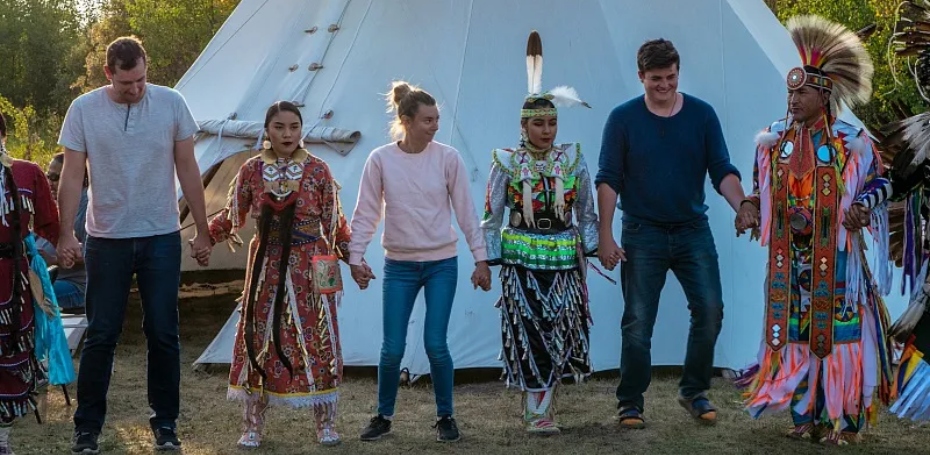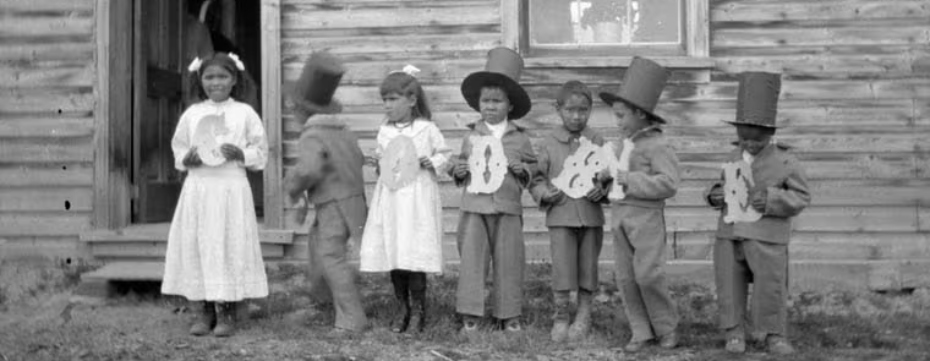
A powerful Canadian series that challenges prejudice and helps people truly understand each other.
- TV Series | 2018–2019
- Genre: Documentary, Reality, Social Experiment
- IMDb Rating: 8.9/10
- Seasons: 2 (6 Episodes Total)
- Production Companies: Animiki See Digital Productions, Indios Productions, Nüman Films
Series Overview
“First Contact” is a Canadian aboriginal documentary that follows six non-Indigenous Canadians over a 28-day journey into Indigenous communities across the country. The show confronts deep-seated prejudice, systemic racism, and cultural ignorance, guiding participants toward empathy, understanding, and personal transformation.
Featured Cast
Season 1
- Laurianne – Former corrections worker from Prince Albert, SK
- Jackson – History student and parrot enthusiast from Midland, ON
- Stephanie – Mother of seven and local political chair from Tyndall, MB
- Samantha – Event coordinator and wildlife volunteer from Whitby, ON
- Larry – Conservative retail worker and outdoorsman from Brantford, ON
- Brennen Kovic – Outspoken Croatian Canadian podcast host from Mississauga, ON
Season 2
- Jamie-Sue – Factory worker and painter from Ingersoll, ON
- Donald – Retired pilot and scuba instructor from Ardrossan, AB
- Ashley Mathieu – Former RCMP officer turned personal trainer from Ottawa, ON
- Avonlea – Stay-at-home mom and former event planner from Chilliwack, BC
- Ross – Navy veteran and family man from Edmonton, AB
- Dallas – Journeyman welder and Big Brother Canada contestant from Saint John, NB
Episode Guide
Each episode introduces the audience to different communities and issues, offering new insights and challenges for the participants.
Season 1 (2018)
- The Journey Begins – Winnipeg, Kimmirut
- A Group Divided – Muskrat Dam, Maskwacis
- A Road to Healing – Calgary, Edmonton, Ahousaht
Season 2 (2019)
- You Don’t Know Me Until You’ve Met Me – Ottawa, Kanasatake, Natuashish
- Changing the Lens – Thunder Bay, Fort William, Mohawk Institute
- Bridging the Divide – Saskatoon, Red Pheasant, Prince Albert, Carcross/Tagish
Historical Context

First Contact looks at key events in Canada’s history that still affect Indigenous communities today. One of the key topics is the 60s Scoop – a period when thousands of Indigenous children were taken from their families and placed in non-Indigenous foster or adoptive homes. Many of these children lost their language, their culture, and a sense of who they were.
The show also focuses on the lasting harm caused by residential schools. These were government- and church-run institutions meant to force Indigenous children to give up their traditions and languages. The schools were often abusive, and the trauma they caused still affects families and communities today.
Another important moment covered is the Oka Crisis of 1990. This was a standoff in Kanasatake, Quebec, where Mohawk land defenders protested against a golf course expansion on sacred land. The conflict drew national attention and became a symbol of Indigenous resistance and the ongoing struggle for land rights.
The Colten Boushie case in 2016 is also addressed. Colten, a young Cree man, was shot and killed in Saskatchewan. The man accused of the shooting was acquitted, which sparked public outrage and highlighted the racism that still exists in Canada’s legal system.
Land disputes are another ongoing issue. Many First Nations are still waiting for fair treatment of treaties signed long ago. Some of these agreements have been ignored or broken. Meanwhile, the Indian Act – a law from the colonial era – still affects how Indigenous communities are governed, often limiting their ability to make decisions for themselves.
These aren’t just things from the past. Through this powerful First Nations documentary, viewers can see how these issues are still very real today, from land resistance in Kanasatake to the ongoing challenges in an Innu location like Natuashish. As an Indigenous TV series, First Contact brings these stories forward with honesty and clarity, helping more people understand the realities Indigenous communities face across Canada.
Indigenous Realities in a Connected Canada
First Nations and Indigenous communities face distinct challenges when it comes to digital infrastructure and economic equity. Yet, many communities are also finding new ways to adapt modern technologies in alignment with traditional values, whether in education, governance, or commerce.
Online Gambling and Community Resilience
As internet access improves across rural and remote regions, online gambling has become a modern issue that some First Nations communities are beginning to address directly. While not featured in the series, it reflects the same themes explored in First Contact, how Indigenous communities face and adapt to evolving challenges.
Online gambling, now regulated in parts of Canada, is growing in popularity, including in Indigenous regions. Some First Nations are involved in broader conversations about revenue-sharing, licensing, and digital casino models. Others are raising concerns about youth exposure, mental health risks, and the long-term effects of easy access to online gaming.
In response, Indigenous leaders and organizations are advocating for culturally grounded harm-reduction programs. These approaches focus on education, balance, and wellness, centering traditional values while navigating digital realities.
Featured Indigenous Communities
Throughout both seasons of First Contact, the participants travel to Indigenous communities across Canada. Each location offers a unique window into the challenges, traditions, and resilience of the people who live there.
Kimmirut, Nunavut
This Inuit community lies in the Canadian Arctic, where living conditions are shaped by isolation and climate. In Kimmirut, participants learn about food insecurity, the high cost of imported goods, and the cultural importance of sharing within the community. Traditional hunting and fishing still play a key role in everyday life.
Muskrat Dam, Ontario
A fly-in First Nation community in Northern Ontario, Muskrat Dam highlights the limitations that come with remote access. The show explores how youth education is impacted by geography, underfunded schools, and infrastructure gaps. It also provides insight into the emotional and historical toll of residential school experiences still remembered by elders.
Red Pheasant, Saskatchewan
Red Pheasant Cree Nation is located in Saskatchewan and is strongly connected to the story of Colten Boushie, a young man whose death and the court case that followed sparked national discussions on racism and justice. The community shares how spirituality and tradition are central to healing from both historical and recent trauma.
North Battleford, Saskatchewan
Surrounded by several Indigenous nations, including Poundmaker and Sweetgrass, North Battleford has a deep connection to Indigenous resistance, including the North-West Rebellion. Participants learn about the area’s colonial history, the long-standing tensions following the Gerald Stanley trial, and recent efforts by local Nations to reclaim land and build self-sustaining economies.
Natuashish, Newfoundland and Labrador
Originally relocated from Davis Inlet, Natuashish is home to the Mushuau Innu people. This community has faced serious social challenges stemming from colonization and forced relocation. The series focuses on the efforts of community members to restore cultural pride and improve conditions through connection to land and tradition.
Carcross/Tagish, Yukon
Carcross/Tagish First Nation stands as an example of modern self-governance. After negotiating a land claims agreement, the community now manages many of its own affairs, including cultural programs and economic initiatives. Participants meet locals working in traditional roles such as carving and medicinal plant gathering, showing how heritage and progress can go hand in hand.
Kanasatake, Quebec
Best known as the site of the 1990 Oka Crisis, Kanasatake is a Mohawk community with a long history of resistance. In the show, participants visit the sacred pine forest that was once threatened by a golf course expansion. Elders and leaders explain the legacy of that standoff and how it continues to influence Indigenous activism in Canada.
Fort William, Ontario
Located near Thunder Bay, Fort William First Nation is an Ojibwe community working toward economic self-determination. The participants see how the community balances traditions with modern development. Despite challenges under the Indian Act, Fort William is reclaiming its governance and legal frameworks rooted in Anishinaabe law and stories.
Six Nations of the Grand River, Ontario
The largest First Nations reserve by population in Canada, Six Nations is home to all six Iroquois nations. Participants learn about the Haudenosaunee Confederacy and its governance system, based on the Great Law of Peace. The community’s ongoing legal battles over land rights highlight Canada’s unfinished work on reconciliation and treaty obligations.
🎬 Production Details
- Narrator: George Stroumboulopoulos brings a familiar voice to guide the journey.
- Format: Adapted from the 2014 Australian series of the same name.
- Development: Initially rejected by many broadcasters, it found a home on APTN and TVO.
- Production Approach: Led by Indigenous producers and filmmakers, the series prioritizes authentic voices and community collaboration.
Awards & Recognition
First Contact has earned two major award nominations, including a nod at the Canadian Screen Awards. But perhaps more importantly, the series has become a valuable resource in classrooms, universities, and diversity training programs across Canada.
Educators, human rights advocates, and community organizations have praised the show for its respectful and honest portrayal of Indigenous realities. It’s one of the few programs that effectively bridges storytelling, education, and social impact. In many ways, it has become more than a TV show, it’s a resource for learning.
User Reviews & Reactions
First Contact received strong praise for its raw and honest portrayal of Indigenous realities and the personal transformation of its participants.
One viewer wrote on IMDb:
“The show takes blissfully ignorant white people of many different backgrounds and biases and shows them what Indigenous Canada is really like… It is a very insightful show as it has authentic stories and voices, which is really the most important.”
— mjcolton, IMDb
Many viewers said the series changed how they saw Canada’s history and present-day issues. People connected with the participants’ emotional shifts – some came in defensive or unaware, but by the end, many had opened their minds and hearts.
Critics and educators praised the show’s unfiltered storytelling and the space it gave to Indigenous voices. A few viewers said they wished the show had offered follow-up episodes to show what happened after filming ended. Still, most agreed it was an important tool for education, empathy, and starting real conversations.
Where to Watch It in 2025
You can stream the full First Contact series on APTN Lumi or watch it through Apple TV. Both platforms offer access to all episodes from Seasons 1 and 2. Make sure to check availability by region and platform for full access.
